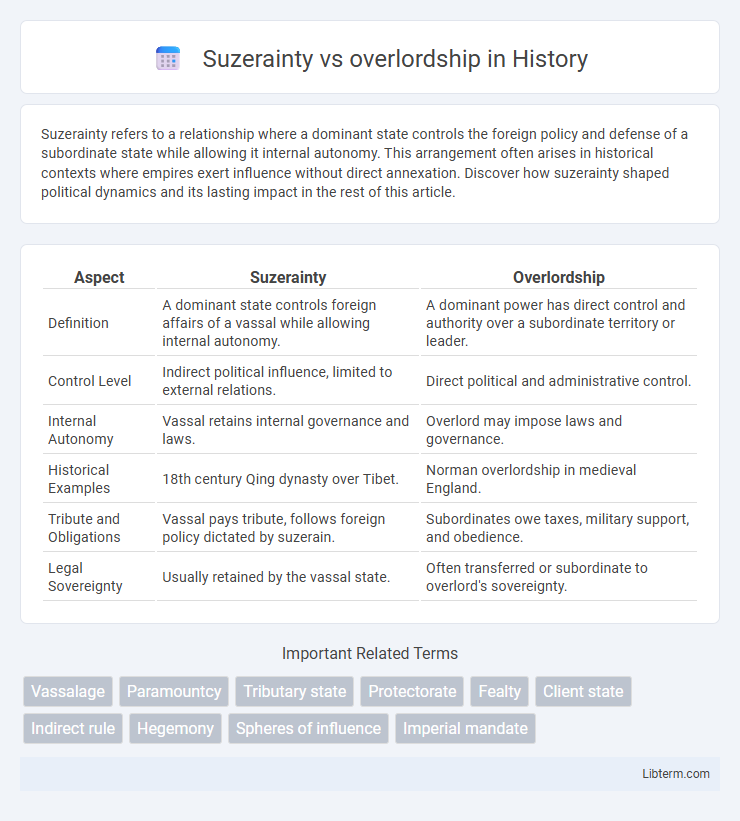Suzerainty refers to a relationship where a dominant state controls the foreign policy and defense of a subordinate state while allowing it internal autonomy. This arrangement often arises in historical contexts where empires exert influence without direct annexation. Discover how suzerainty shaped political dynamics and its lasting impact in the rest of this article.
Table of Comparison
| Aspect | Suzerainty | Overlordship |
|---|---|---|
| Definition | A dominant state controls foreign affairs of a vassal while allowing internal autonomy. | A dominant power has direct control and authority over a subordinate territory or leader. |
| Control Level | Indirect political influence, limited to external relations. | Direct political and administrative control. |
| Internal Autonomy | Vassal retains internal governance and laws. | Overlord may impose laws and governance. |
| Historical Examples | 18th century Qing dynasty over Tibet. | Norman overlordship in medieval England. |
| Tribute and Obligations | Vassal pays tribute, follows foreign policy dictated by suzerain. | Subordinates owe taxes, military support, and obedience. |
| Legal Sovereignty | Usually retained by the vassal state. | Often transferred or subordinate to overlord's sovereignty. |
Defining Suzerainty and Overlordship
Suzerainty refers to a relationship where a dominant state controls the foreign affairs and defense of a vassal state while allowing internal autonomy. Overlordship denotes a superior authority's control over subordinate states or territories, often involving direct political and military influence. Both concepts emphasize hierarchical sovereignty but differ in the extent of control exercised over the subordinate entity.
Historical Origins of Suzerainty
Suzerainty originated in medieval political systems where a dominant state, the suzerain, exercised control over the foreign affairs and tribute of a vassal state while allowing internal autonomy. This concept developed prominently in Eurasian empires, such as the Chinese tributary system and the Ottoman Empire's relationships with semi-independent territories. Overlordship typically implies direct control over both domestic and foreign policies, whereas suzerainty emphasizes a hierarchical but looser form of domination rooted in historical feudal or imperial traditions.
The Evolution of Overlordship
The evolution of overlordship traces its roots to medieval political structures where dominant rulers exerted authority over subordinate lords, shaping feudal hierarchies. Overlordship developed as a system of control through vassalage, military support, and tribute, contrasting with suzerainty's emphasis on limited autonomy under a supreme ruler. Key historical examples include the Holy Roman Empire and Mongol Empire, illustrating shifts from personal loyalty bonds to more institutionalized forms of overlordship.
Key Differences Between Suzerainty and Overlordship
Suzerainty involves a relationship where the suzerain controls the foreign affairs and defense of a vassal state while allowing internal autonomy, whereas overlordship entails more direct control and authority over the vassal's internal and external matters. Suzerainty is commonly seen in historical contexts such as the Ottoman Empire's control over tributary states, contrasting with overlordship examples like the British Raj in India. The key difference lies in the degree of power exercised: suzerainty grants limited sovereignty to the subordinate, while overlordship imposes comprehensive domination.
Suzerainty in Ancient and Medieval Empires
Suzerainty in ancient and medieval empires referred to a dominant state's control over a vassal state that retained internal autonomy while ceding foreign policy and tribute obligations. Prominent examples include the relationship between the Chinese empire and its neighboring tributary states, where the suzerain exercised indirect control without full annexation. This system allowed empires like the Mongol Empire and the Ottoman Empire to expand influence efficiently by maintaining hierarchical but semi-independent political structures.
Overlordship in Feudal Societies
Overlordship in feudal societies denotes the authority exercised by a superior lord over subordinate vassals who owe allegiance and services in exchange for protection or land tenure. This hierarchical system facilitated political cohesion and military support, with overlords possessing rights to collect taxes, administer justice, and command troops within their domain. The relationship was formalized through ceremonies such as homage and fealty, reinforcing the overlord's control and the vassals' obligations within the feudal structure.
Legal Implications of Suzerainty vs Overlordship
Suzerainty entails a legal relationship where the suzerain has limited authority over a vassal state, primarily in foreign affairs and defense, while the vassal retains substantial internal governance autonomy. Overlordship implies a broader legal control, with the overlord exercising significant influence or direct control over both internal administration and external matters of the subordinate territory. The distinction affects treaty rights, sovereignty acknowledgment, and the extent of judicial and military obligations imposed on the subordinate entity.
Case Studies: Famous Examples in History
The Mughal Empire's relationship with Rajput kingdoms illustrates suzerainty, where Rajput rulers maintained internal autonomy but acknowledged Mughal supremacy and paid tribute. The British Empire's control over princely states in India exemplifies overlordship, as Britain exercised ultimate authority, directing foreign policy and defense while allowing nominal local governance. In medieval Europe, the Holy Roman Emperor's overlordship over various German princes showcased a fragmented authority, with emperors asserting supremacy but encountering significant regional independence.
Modern Interpretations and Relevance
Modern interpretations of suzerainty emphasize its role as a nuanced form of sovereignty where the dominant state controls foreign relations while allowing internal autonomy to the vassal state. Overlordship in contemporary contexts often denotes a hierarchical authority with broader control, including administrative or military dominance. Both concepts remain relevant in analyzing neo-colonialism, regional power dynamics, and international law regarding state sovereignty and influence.
Comparing Suzerainty and Overlordship in International Relations
Suzerainty refers to a relationship where a dominant state controls the foreign affairs and defense of a vassal state while allowing internal autonomy, whereas overlordship implies more direct control over both internal and external policies of the subordinate entity. In international relations, suzerainty is often characterized by limited sovereignty of the vassal state, retaining some self-governance, while overlordship denotes a higher degree of dominance and dependency, often reducing the subordinate state's sovereignty substantially. The distinction lies in the scope of control and autonomy, with suzerainty representing a looser, more diplomatic hierarchy and overlordship indicating a stricter, more authoritative power dynamic.
Suzerainty Infographic

 libterm.com
libterm.com